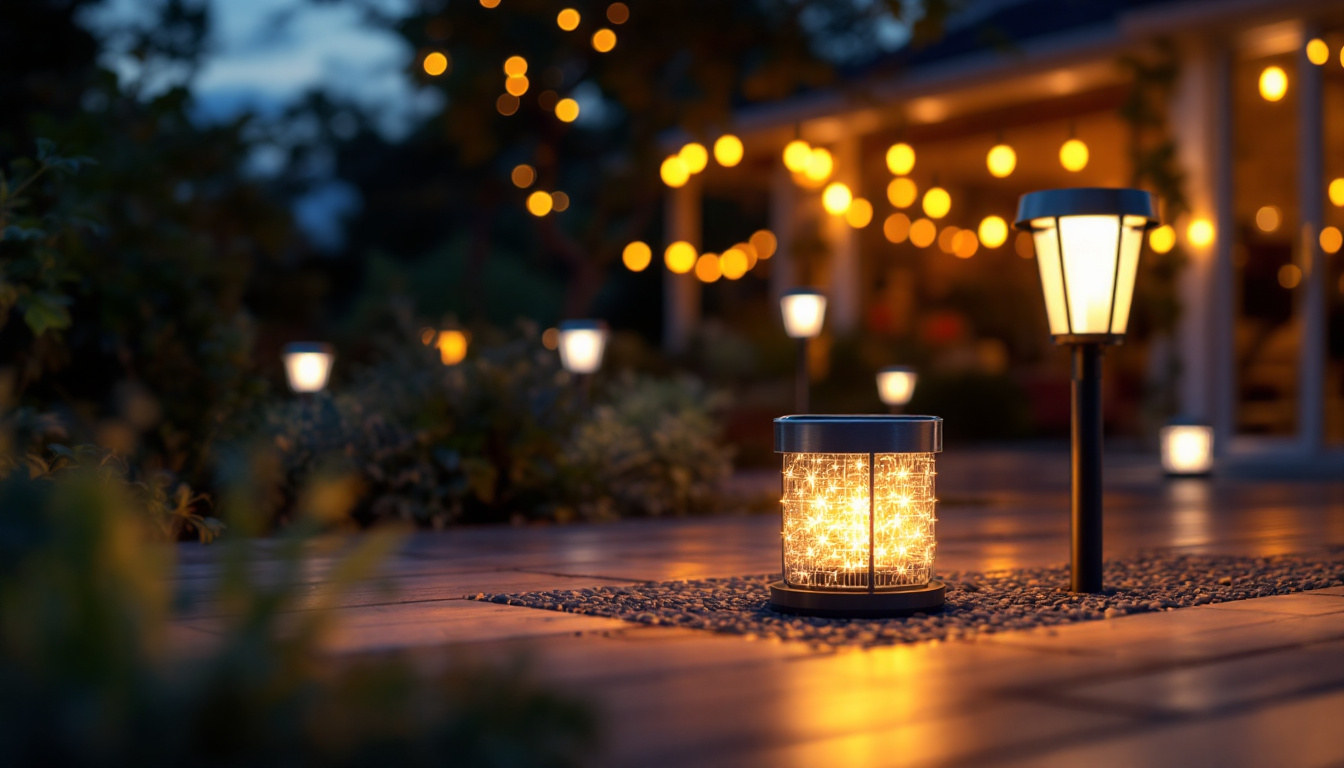

As the demand for sustainable and energy-efficient solutions continues to rise, solar-powered lights have emerged as a popular choice for outdoor lighting projects. For lighting contractors, understanding the nuances of solar technology and its applications can significantly enhance the value offered to clients. This article delves into the various approaches that smart lighting contractors can adopt when integrating solar-powered lights into outdoor environments.
Before diving into the practical applications of solar-powered lights, it is essential to grasp the fundamental principles of solar technology. Solar lighting systems harness energy from the sun, converting it into electricity through photovoltaic cells. This process not only reduces reliance on traditional power sources but also minimizes the carbon footprint associated with outdoor lighting. The efficiency of these systems has improved significantly over the years, making them a viable option for both residential and commercial applications. As technology advances, the cost of solar panels continues to decrease, making solar energy an increasingly attractive choice for sustainable living.
A typical solar lighting system consists of several key components: solar panels, batteries, LED lights, and a controller. Each element plays a crucial role in ensuring the system operates efficiently. Solar panels capture sunlight and convert it into electrical energy, which is stored in batteries for use during nighttime. LED lights are favored for their energy efficiency and longevity, while the controller manages the energy flow, ensuring optimal performance. Additionally, many modern systems come equipped with sensors that detect ambient light levels, allowing them to automatically turn on and off based on the surrounding light conditions, further enhancing energy efficiency.
Understanding these components allows contractors to make informed decisions when selecting and installing solar lighting systems. Each component’s specifications can significantly impact the overall effectiveness of the lighting solution. For instance, the capacity of the battery determines how long the lights can operate during periods of low sunlight, while the wattage of the solar panels affects how quickly the batteries can be charged. By carefully considering these factors, contractors can design systems that meet specific energy needs and ensure reliable performance throughout the year.
There are various types of solar-powered lights available, each designed for specific applications. Pathway lights, floodlights, and decorative lanterns are just a few examples. Pathway lights are ideal for illuminating walkways, while floodlights can provide security lighting for larger areas. Decorative lanterns add aesthetic appeal to gardens and patios. Moreover, solar street lights are becoming increasingly popular in urban areas, providing efficient lighting solutions for public spaces without incurring high energy costs. These lights not only enhance safety but also contribute to the overall ambiance of the neighborhood.
Contractors should assess the specific needs of each project to determine which type of solar light will best suit the environment and client preferences. This tailored approach not only enhances functionality but also ensures client satisfaction. For instance, in a residential setting, homeowners may prefer softer, ambient lighting for their gardens, while commercial properties might require brighter, more focused lighting for security purposes. By understanding the unique requirements of each installation, contractors can recommend the most suitable solar lighting options, ensuring that every project is both practical and visually appealing.
The advantages of solar-powered lights extend beyond environmental benefits. For contractors, these systems offer several compelling reasons to incorporate them into outdoor projects.
One of the most significant benefits of solar-powered lights is their cost efficiency. While the initial investment may be higher compared to traditional lighting systems, the long-term savings on electricity bills and maintenance costs can be substantial. Solar lights require minimal maintenance, as they do not have wiring that can be damaged or require replacement bulbs.
Additionally, many regions offer incentives or rebates for solar installations, further reducing the overall cost for clients. This financial aspect can be a strong selling point for contractors looking to promote solar lighting solutions.
Solar-powered lights contribute to a greener environment by utilizing renewable energy. By reducing dependence on fossil fuels, these systems help lower greenhouse gas emissions. For contractors, promoting environmentally friendly solutions can enhance their reputation and appeal to a growing demographic of eco-conscious clients.
Moreover, solar lights can be installed in remote areas where traditional electrical infrastructure is unavailable, making them an excellent solution for off-grid lighting needs. This versatility opens up new opportunities for contractors to expand their service offerings.
While the benefits of solar-powered lights are clear, successful installation requires careful planning and execution. Contractors must consider several factors to ensure optimal performance and longevity of the systems.
Conducting a thorough site assessment is crucial before installation. Factors such as sunlight exposure, shading from trees or buildings, and the overall landscape can significantly impact the efficiency of solar lights. Contractors should evaluate the site to determine the best locations for solar panels and lights, ensuring they receive adequate sunlight throughout the day.
Additionally, understanding the local climate can help in selecting the appropriate solar lighting systems. For instance, areas with frequent cloud cover may require lights with larger battery capacities to ensure they perform effectively during extended periods of low sunlight.
Once the site assessment is complete, the next step is to determine the proper placement and orientation of the solar lights. Solar panels should be positioned to maximize sun exposure, typically facing south in the northern hemisphere. This orientation ensures that the panels receive the most sunlight throughout the day, enhancing their efficiency.
When installing the lights, contractors should also consider the desired brightness and coverage area. Proper placement can prevent dark spots and ensure that pathways, gardens, or other outdoor spaces are adequately illuminated.
Although solar-powered lights require minimal maintenance, regular checks can help prolong their lifespan and maintain optimal performance. Contractors should educate clients on the importance of routine maintenance to ensure their solar lighting systems continue to function effectively.
Dust, dirt, and debris can accumulate on solar panels, reducing their efficiency. Regular cleaning is essential to ensure that the panels can absorb maximum sunlight. Contractors can recommend a cleaning schedule based on the local environment, advising clients to use a soft cloth or sponge with mild soap and water for cleaning.
In areas with heavy pollen or dust, more frequent cleaning may be necessary. Educating clients on this aspect can enhance their satisfaction and the overall performance of the solar lighting system.
Batteries are a critical component of solar lighting systems, and their maintenance is vital for ensuring longevity. Contractors should inform clients about the signs of battery wear, such as reduced lighting duration or dimming lights. Regularly checking battery connections and ensuring they are free from corrosion can also help maintain optimal performance.
In some cases, batteries may need to be replaced after a few years of use. Offering a replacement service can be an additional revenue stream for contractors while ensuring clients have a reliable lighting solution.
Incorporating solar-powered lights into outdoor designs requires a thoughtful approach. Contractors should consider the aesthetic aspects of the lighting in addition to functionality. A well-designed solar lighting solution can enhance the beauty of outdoor spaces while providing practical illumination.
When designing solar lighting systems, it is essential to consider how the lights will blend with the surrounding landscape. Choosing fixtures that complement the architectural style of the property and the natural elements of the landscape can create a harmonious look.
Contractors can offer a variety of styles and finishes, from sleek modern designs to rustic lanterns, allowing clients to select options that align with their vision for the outdoor space. This attention to detail can significantly enhance the overall appeal of the project.
Solar-powered lights can also be used to create ambiance in outdoor settings. By strategically placing lights to highlight specific features, such as trees, water features, or architectural elements, contractors can enhance the overall atmosphere of the space.
Using dimmable solar lights or those with adjustable brightness settings can further enhance the versatility of the lighting design, allowing clients to customize the ambiance for different occasions.
The solar lighting industry is continuously evolving, with new technologies and trends emerging regularly. Staying informed about these developments can help contractors remain competitive and offer cutting-edge solutions to clients.
One of the most exciting trends in solar lighting is the integration of smart technology. Smart solar lights can be controlled remotely via mobile apps, allowing users to adjust brightness, set timers, and monitor energy usage. This level of control adds convenience and enhances the overall user experience.
Contractors who embrace smart solar lighting systems can offer clients innovative solutions that align with modern technological advancements. This can be particularly appealing to tech-savvy clients looking for the latest in outdoor lighting solutions.
Advancements in battery technology are also paving the way for more efficient solar lighting systems. Newer battery types, such as lithium-ion, offer longer lifespans and improved performance in varying weather conditions. These enhancements can significantly improve the reliability of solar-powered lights, making them an even more attractive option for outdoor lighting.
Contractors should stay updated on these developments to provide clients with the most efficient and reliable solar lighting solutions available. By doing so, they can position themselves as industry leaders in sustainable lighting practices.
Solar-powered lights present a wealth of opportunities for lighting contractors. With their numerous benefits, including cost efficiency, environmental impact, and versatility, these systems are becoming increasingly popular in outdoor lighting applications. By understanding the technology, installation considerations, maintenance requirements, and design possibilities, contractors can effectively integrate solar lighting solutions into their projects.
As the industry continues to evolve, staying informed about emerging trends and advancements will be crucial for contractors looking to remain competitive. By embracing solar-powered lights, lighting contractors can not only enhance their service offerings but also contribute to a more sustainable future.
Ready to elevate your outdoor lighting projects with the most cost-efficient, environmentally friendly, and versatile solar-powered lights? Look no further than LumenWholesale. We provide lighting contractors with spec-grade lighting products that meet the highest industry standards. Our direct-to-contractor approach ensures you get unbeatable wholesale prices, free shipping, and the convenience you need for all your bulk buying requirements. Enhance your service offerings and lead the way to a sustainable future with our premium lighting solutions. Wholesale Lighting at the Best Value is just a click away. Step into the light with LumenWholesale today.

Discover how mastering 3-way switches can revolutionize efficiency for lighting contractors, saving both time and money.

Explore the essential insights and innovative solutions offered by Veritas Light Ca, designed specifically for lighting contractors.

Discover the essential insights lighting contractors need to master bathroom vanity lighting.

Discover the essential insights lighting contractors need to know about wafer lights.
Get notified when NEW deals are released.
Optimize your budget with wholesale discounts.
Only top-quality, specification-grade lighting products.
No additional costs at checkout - what you see is what you pay.
We understand the unique needs of contractors.